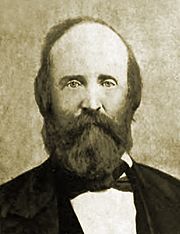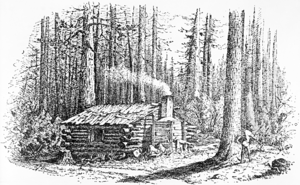Asa Lovejoy facts for kids
Quick facts for kids
Asa Lovejoy
|
|
|---|---|
 |
|
| Speaker of the Provisional Legislature of Oregon | |
| In office December 1, 1846 – December 19, 1846 |
|
| Preceded by | Henry A. G. Lee |
| Succeeded by | Robert Newell |
| Speaker of the Oregon Territory House of Representatives | |
| In office July 16, 1849 – September 29, 1849 |
|
| Preceded by | Levi A. Rice (Provisional Legislature) |
| Succeeded by | Ralph Wilcox |
| Constituency | Clackamas County |
| Delegate to the Oregon Constitutional Convention | |
| In office August 17, 1857 – September 18, 1857 |
|
| Constituency | Clackamas County |
| Personal details | |
| Born | March 14, 1808 Groton, Massachusetts |
| Died | September 10, 1882 (aged 74) Oregon |
| Political party | Democratic |
| Spouse | Elizabeth McGary |
Asa Lawrence Lovejoy (born March 14, 1808 – died September 10, 1882) was an important American pioneer and politician. He helped settle the area that later became the state of Oregon. He is most famous for being one of the founders of the city of Portland, Oregon.
Before moving west, Lovejoy was a lawyer in Boston, Massachusetts. He traveled to Oregon by land. In Oregon, he became a leader in the early Provisional Government of Oregon. He was also the mayor of Oregon City. During the Cayuse War in 1847, he served as a general. He even ran for governor before Oregon became a U.S. territory.
Lovejoy continued his political work after Oregon became a territory. He served in both parts of the Oregon Territorial Legislature. In 1849, he was the first Speaker of the Oregon House of Representatives. He also helped write the Oregon Constitution in 1857. This document prepared Oregon to become a state. Later in life, he owned part of a newspaper and worked on railroad projects. Today, Lovejoy Street and Lovejoy Fountain in Portland are named after him.
Contents
Early Life and Moving West
Asa Lovejoy was born in Groton, Massachusetts, on March 14, 1808. His parents were Betsy Lovejoy and Doctor Samuel Lovejoy. He went to college at Cambridge College and Amherst College. After college, he studied law and became a lawyer in Maine.
He later moved west to Missouri. However, he left Missouri for the Oregon Country because of poor health. The Oregon Country was a large area in the Pacific Northwest that was not yet organized into a state or territory.
Adventures in Oregon Country
Lovejoy first traveled to the Oregon Country in 1842. He came on the Oregon Trail with a group led by Elijah White. They arrived at the Whitman Mission in what is now eastern Washington. On this trip, he was briefly held by Native Americans.
At the mission, Lovejoy decided to travel back east with Marcus Whitman during the winter. He returned to Oregon in 1843 as part of the "Great Migration." This large group of settlers helped make the Oregon Trail popular. When he returned, Lovejoy started his law practice in Oregon City. This city was the center of government during the early Provisional Government period.
Founding Portland
In 1843, Lovejoy and his travel partner, William Overton, shared a claim to a large piece of land. This land was about 640 acres (2.6 km2) along the Willamette River. This area later became part of downtown Portland. Overton later sold his share to Francis Pettygrove.
In 1845, Lovejoy and Pettygrove had a famous coin toss. They wanted to decide the name of the new town they were planning. Each man wanted to name it after his hometown. Pettygrove, from Portland, Maine, won the toss. So, the town became known as Portland, Oregon. They planned out sixteen blocks of the town that year. Lovejoy later sold his part of the land to Benjamin Stark in 1845.
Also in 1845, Lovejoy married Elizabeth McGary. They had five children: William, Amos, Ada, Elizabeth, and Nellie.
Lovejoy's Political Career

In 1844, Asa Lovejoy was chosen to be part of the Provisional Legislature of Oregon. He represented Clackamas District. In 1845, he ran for the new office of governor. This office replaced the earlier Executive Committee. George Abernethy won that election. Even though he lost the governor's race, Lovejoy was elected mayor of Oregon City that same year.
Lovejoy returned to the legislature in 1846 and served as its Speaker. In 1847, he ran for governor again against Abernethy, but lost by a small number of votes. From 1847 to 1848, he served as a general during the Cayuse War. This war happened after the Whitman massacre.
In 1848, Lovejoy was elected to the last session of the Provisional Legislature. He represented the Vancouver District, north of the Columbia River. However, he resigned before the session began. In September 1848, he went to California during the California Gold Rush. He returned to Oregon in January 1849. The Provisional Government ended in March 1849 when the new U.S. territorial government arrived.
Serving in the Oregon Territory
When the Oregon Territory government started in March 1849, a new legislature was created. Lovejoy was elected to its first session. He served in the lower house, called the Oregon House of Representatives. Representing Clackamas District again, he became the first Speaker of the Oregon Territorial Legislature.
In 1851, he returned to the legislature, serving in the upper house, called the Council. The next year, he stayed in the Council, but was elected as a member of the Whig Party. In 1854, he was back in the House of Representatives. In 1856, he served in one last session, this time as a member of the Democratic Party.
In 1857, Lovejoy represented Clackamas County at the Oregon Constitutional Convention in Salem. This meeting created the Oregon Constitution. This document was needed for the territory to become a U.S. state. Lovejoy was a Democrat and led the committee that decided the state's boundaries. He also worked on the committee for legislative matters. The convention finished on September 18, 1857. The public voted to approve the Constitution on November 9. On February 14, 1859, Oregon officially became the 33rd state.
Later Life and Legacy
He endured the adventures of the plains and mountains, and here—beside the Willamette chose and wisely developed the site of the greatest city of the Columbia valley, afterward holding many offices of public trust, and passing with the esteem of all.
In his later years, Asa Lovejoy was involved in different businesses in Oregon. He was a major owner of the Oregon Telegraph newspaper. He was also the vice-president of the Willamette Steam Navigation Company.
Lovejoy passed away on September 10, 1882, at age 74. He was buried in the Masonic section of Lone Fir Cemetery in Portland. Lovejoy Street in Portland is named after him. The character Reverend Timothy Lovejoy in The Simpsons is named after this street. The fountain at Lovejoy Fountain Park in downtown Portland is also named in his honor.
See Also



